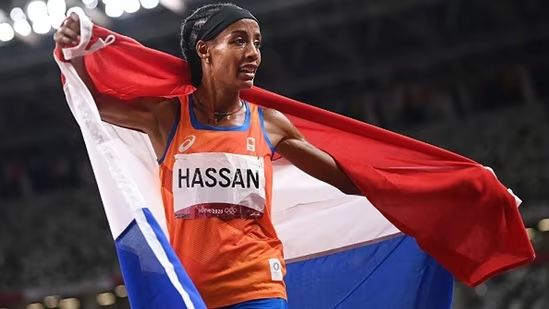Tokyo 2020: The hunt for the impossible treble
Paavo Nurmi had a problem. One of the Flying Finns of the 1920s (the other was compatriot Ville Ritola), Nurmi was the world’s pre-eminent runner in any distance above 800m by the time the Paris Olympics came along. The problem was that his two main events – the 1,500m and the 5,000m – were scheduled just an hour apart at the 1924 Games.

Could he run one, recover, then run the other?
Nurmi decided to give himself a test. Three weeks before his Olympics events, he organised the two races in Helsinki, with 55 minutes between the end of the one and the start of the other.
On June 19, 1924, Nurmi ran the 1,500m in 3 minutes, 52.6 seconds. Then, he ran the 5,000m in 14 minutes, 28.2 seconds. There have been several occasions when world records over two distances have been broken on the same day – but never, before or since, have they been broken on the same day by the same person.
Also Read | Tokyo Olympics: Sjoerd Marijne parts ways from Indian hockey on a high
It was no surprise when Nurmi went on to win the 1,500m and 5,000m golds in Paris. He also won the 3,000m, and the cross-country (individual and team) golds, but was not allowed to compete in the 10,000m because the organisers feared for his life. This made Nurmi so angry that he entered a 10,000m race in Finland eight weeks later, and broke that world record too.
The eldest of five siblings, Nurmi was born in Finland’s oldest city, Turku, a year after Athens 1896. His father, a carpenter, died when Nurmi was 13, forcing him to work as an errand boy for a baker. He joined the army after the 1918 Finnish Civil War between the Reds and the Whites.
But Nurmi didn’t care about politics - he was a runner, and his 12 medals in three Olympics are the highest for any track & field athlete in history.
So, was he the greatest ever distance runner at the Olympics?
Also Read | Tokyo Olympics: Golfer Aditi Ashok in line for historic podium finish
Emil Zatopek was born in eastern Czechoslovakia in 1922. At 16, just before the start of the Second World War, he went to work at a Bata factory in Zlin, an hour away from his hometown Koprivnice. The story goes that his boss was very strict, and in 1940, when Bata organised a 1,500m race, everyone under his charge was asked to sign up. Forced into the event, Zatopek, who hadn’t run competitively before, decided midway that he should try and win. He finished second. Had he been first, he may have never run again, Zatopek joked later; but second – no, no, he wouldn’t have that.
And so began an obsession.
Zatopek would train for so long, put his body through so much punishment, and push himself so hard, huffing and puffing through races, that he got the nickname Czech Locomotive – as far removed from the graceful Flying Finn as possible. When Zatopek was once asked why he inflicted all that pain on himself, why he didn’t slow down a bit, he replied: “Why should I practise running slow? I already know how to run slow. I want to learn to run fast.”
At Helsinki 1952, with Nurmi watching, Zatopek decided to match his feat. The Czech won the 5,000m and the 10,000m golds, and then, out of the blue, decided to enter the marathon – a race he’d never participated in before. He won in an Olympic record time of 2 hours, 2 minutes, 3.2 seconds for his third gold.
Also Read | Tokyo Olympics 2020 Full Coverage
Zatopek suffered an injury just before Melbourne 1956, and retired from the sport the following year. He won four Olympic golds to Nurmi’s nine, but the jury has been out for 70 years on which of them was the greatest of all time.
There have been a few middle - and long-distance doubles at the Olympics since then. Ethiopians Tirunesh Dibaba and Kenenisa Bekele each won the 5,000-10,000 at the 2008 Beijing Games. Britain’s Mo Farah won those races twice, in 2012 and 2016. But no one, other than Nurmi and Zatopek, has ever won three individual distance-running golds at the same Olympics.
And that’s why what Sifan Hassan was gunning for at Tokyo 2020 was so important.
Hassan was born in Adama, Ethiopa, in 1993. She went to the Netherlands as a refugee in 2008, started running while studying to be a nurse, and became a Dutch citizen in 2013. A double world champion in the 1,500m and 10,000m at the Doha world championships in 2019, Hassan threw down the gauntlet when she announced before the Olympics that she was going for a golden treble in the 1,500m, 5,000m and 10,000m (a different combination from both Nurmi and Zatopek).
The last person who almost did it was Finland’s Lasse Viren at Montreal 1976, when he got the 5,000-10,000 double but finished fifth in the marathon.
On Monday, August 2, Hassan took gold by nearly two seconds in the 5,000m. But, on Friday, she had to settle for bronze in the 1,500m as Kenya’s Faith Kipyegon broke through before the final bend to set a new Olympic record. The 10,000m is on Saturday.
After a long wait, the Czech Locomotive and the Flying Finn could have got a new entrant – in the form of a Flying Dutchwoman – into the most rarefied of all running clubs. They remain its only members, at least till Paris 2024.
Disclaimer: The copyright of this article belongs to the original author. Reposting this article is solely for the purpose of information dissemination and does not constitute any investment advice. If there is any infringement, please contact us immediately. We will make corrections or deletions as necessary. Thank you.







